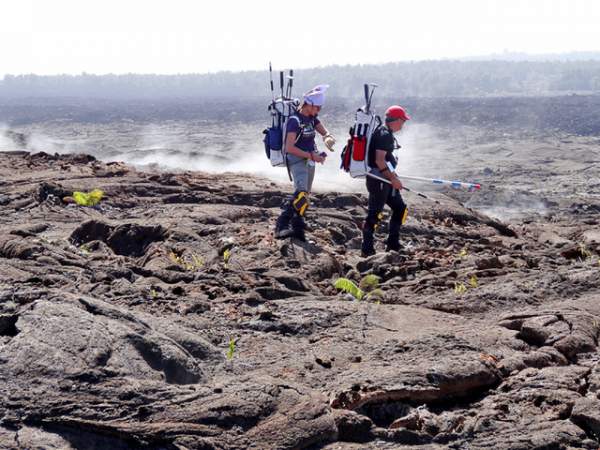UH Hilo, PISCES, NASA Prepare for Mars Mission
The Pacific International Space Center for Exploration Systems (PISCES) is partnering with the University of Hawai‘i at Hilo and NASA this month in a groundbreaking research project to prepare for an eventual manned mission to Mars.
The project, called BASALT (Biologic Analog Science Associated with Lava Terrains), is focused on developing operation protocols for a joint human-robotic exploration of Mars in the search for extraterrestrial life.
BASALT scientists and crew members are conducting simulated missions in two locations which closely resemble the Martian landscape at different areas—Mauna Ulu at Hawaii Volcanoes National Park and the Eastern Snake River Plain in Idaho.
Currently, the BASALT team is investigating Mauna Ulu by traversing the rugged lava terrain to collect rock samples for both biologic and geologic analysis.
“We add a twist to our scientific fieldwork by conducting it under simulated Mars mission constraints,” said Dr. Darlene Lim, geobiologist and principal investigator for the BASALT research project. “By doing so, we can evaluate operational concepts and a variety of supporting capabilities that range from software to hardware components with respect to their anticipated value for the human exploration of Mars.”
One of their constraints is a communication time delay to simulate the latency of transmissions experienced between planets. Dr. Lim and her team are hoping to develop a tricorder-like device, as envisioned in Star Trek, to be able to identify rock samples using a hand-held instrument.
The researchers hope to better understand the habitability of Mars by studying Mauna Ulu, which is a high-fidelity analog for the landscape of early Mars when volcanism and water were common.
“No one has really worked this out yet,” said John Hamilton, PISCES test logistics and education/public outreach manager. “We want to work out the kinks during these exercises so we have it together on a real mission. By the time they go to Mars, they’ll have a rock-solid plan.”
The BASALT team consists of scientists, engineers, mission operators and active astronauts. Roughly a dozen students from the UH-Hilo are also assisting with the project. Hamilton, who is also a faculty member with the UH-Hilo Department of Physics and Astronomy is serving on the BASALT Science Team, overseeing data collection, logistics, and student assignments. The research project is central to NASA’s Journey to Mars program.
“PISCES is honored to be working together with the University of Hawai‘i at Hilo and NASA Ames on this project,” said Rodrigo Romo, PISCES program manager. “Collaborative work with Ames has been in the frontline of applied research for PISCES recently. The fact that university students get the opportunity to participate in events like the BASALT project will help them meet the demands of a very competitive industry.”
PISCES was selected last year by NASA’s highly competitive PSTAR (Planetary Science and Technology Through Analog Research) program to participate in the four-year, $4.2 million BASALT project, which is being administered by the University of Hawaii at Hilo. The BASALT research team will be conducting their research on Hawai‘i Island until Nov. 18.
For more information visit PISCES’ website.
About PISCES
PISCES is a state-funded aerospace center under the Department of Business, Economic Development, and Tourism (DBEDT). PISCES is working to position Hawaii as a leader in space exploration while developing sustainable products and technologies to benefit the Islands. Three core initiatives are at the heart of PISCES’ work: Applied Research, Workforce Development, and Long-term Business and Economic Development. These mutually supportive efforts provide real-life, hands-on experience to Hawaii’s future scientists and engineers, preparing them to meet the demands of a highly competitive industry while improving the local economy through job diversification and new industries.
About DBEDT (Department of Business, Economic Development and Tourism)
DBEDT is Hawaii’s resource center for economic and statistical data, business development opportunities, energy and conservation information, and foreign trade advantages. DBEDT’s mission is to achieve a Hawaii economy that embraces innovation and is globally competitive, dynamic and productive, providing opportunities for all Hawaii’s citizens. Through its attached agencies, the department fosters planned community development, creates affordable workforce housing units in high-quality living environments, and promotes innovation sector job growth.
Sponsored Content
Comments















